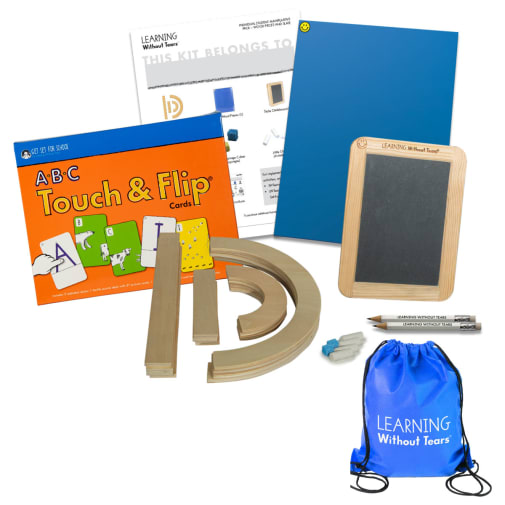Inside this blue drawstring bag is a selected set of basic tools to get your student started using the PK-K Handwriting Without Tears programs. First, the box of 53 A-B-C Touch & Flip® cards, which are divided into letter and picture cards, help students trace and learn capital and lowercase letters. Then, 26 picture cards provide an alphabetical animal puzzle. There are multiple ways to implement these cards in your student’s daily reading and handwriting. The individual manipulative pack provides 13 wood pieces and a blue mat, the slate chalkboard with 4 chalk pieces, 2 sponge cubes, and 2 pencils for little hands. Brief bilingual parent instructions are included. However, you’ll need the program’s Instructor Book for instruction and instruction application. ~ Ruth
Ready for Kindergarten!
SKU
036402
ISBN
9798885665926
Grade PK-K
These icons are designed to help you quickly understand and learn important information about our products.
Teaching Method
Traditional
Teacher-centered curriculum commonly used in classrooms that may include a text, teacher manual, tests, etc.
Charlotte Mason
A methodology based on the work of a 19th century educator who maintained that children learn best from literature (Living Books), not textbooks.
Classical
A methodology based on the Latin Trivium (three stages of learning), including the grammar stage (memorization and facts), logic stage (critical thinking), and rhetoric stage (developing/defending ideas).
Unit Study
A thematic or topical approach centered around one topic that integrates multiple subject areas.
Montessori (Discovery)
A methodology based on the work of a 20th century educator that emphasizes student and sensory-driven discovery learning and real-life applications.
Other
Other methodologies
Religious Content
Secular
Contains content contrary to common Christian beliefs (i.e. evolution).
Neutral
Avoids religious or theoretical topics or presents multiple viewpoints without preference.
Christian/Religious
Faith-based or including instructional religious content.
Learning Modality
Auditory
Learns through listening, talking out loud or reading out loud.
Visual
Learns through seeing, prefers written instructions and visual materials.
Kinesthetic/Tactile (Hands-On)
Learns through moving, doing and touching.
Multi-Sensory
Curriculum that employ a variety of activities/components.
Presentation
Sequential
Curriculum progresses through well-defined learning objectives. Emphasizes mastery before moving to the next topic.
Spiral
Topics and concepts are repeated from level to level, adding more depth at each pass and connecting with review.
Conceptual/Topical
Focus is on the “why,” often with a unifying concept as well as specific skills; coverage may be broader.
Teacher Involvement
Low Teacher Involvement
Student-led materials; parent acts as a facilitator.
Medium Teacher Involvement
A mix of teacher-led time and independent student work.
High Teacher Involvement
Teacher-led lessons; may utilize discussions, hands-on activities and working together.
Additional Materials Required
No other materials needed
Everything you need is included.
Other Materials Required
There are additional required resources that are a separate purchase.
Other Materials Optional
There are additional resources mentioned or recommended but are not absolutely necessary.
Consumable
Consumable
Designed to be written in; not reusable.
Non-Consumable
Not designed to be written in; reusable.
Our Price
$37.50 Product Overview
- Add a student and teacher book for complete K handwriting program
- A basic manipulative set for PK or K learners that travels well
- A great way to introduce your child to the Handwriting Without Tears program
Description
Publisher's Description of Ready for Kindergarten!
Getting ready for kindergarten has never been more fun! With the flip of a card, children will build connections between letters and visual illustrations. The Wood Pieces, Mat, and Slate Chalkboard help little learners build and practice capital letter writing skills. Includes a durable drawstring bag for easy storage and At-Home Learning Guide. (Grade: Pre-K)
The set includes:
- A-B-C Touch & Flip Cards - 2 alphabet decks (1) lowercase matching and (1) tactile and puzzle building
- Wood Pieces: 4 Big Lines, 3 Big Curves, 3 Little Lines, 3 Little Curves (needed to build all capital letters)
- Mat for Wood Pieces (1)
- Slate Chalkboard (1)
- Little Sponge Cubes (2)
- Little Chalk Bits (4)
- Pencils for Little Hands (2)
- At-Home Learning Guide
- Drawstring Storage Bag
The set includes:
- A-B-C Touch & Flip Cards - 2 alphabet decks (1) lowercase matching and (1) tactile and puzzle building
- Wood Pieces: 4 Big Lines, 3 Big Curves, 3 Little Lines, 3 Little Curves (needed to build all capital letters)
- Mat for Wood Pieces (1)
- Slate Chalkboard (1)
- Little Sponge Cubes (2)
- Little Chalk Bits (4)
- Pencils for Little Hands (2)
- At-Home Learning Guide
- Drawstring Storage Bag
Category Description for Letters & Numbers for Me (Grade K)
Teaches capitals, lowercase letters, and numbers through developmentally appropriate activities. Once learned, students will practice through a variety of writing activities that includes writing sentences, rhymes, simple poems, and more
Details
| Product Format: | Other |
|---|---|
| Grades: | PK-K |
| Brand: | Handwriting Without Tears |
| ISBN: | 9798885665926 |
| Length in Inches: | 10 |
| Width in Inches: | 11.25 |
| Height in Inches: | 2.5 |
| Weight in Pounds: | 2.35 |
Videos
Reviews

